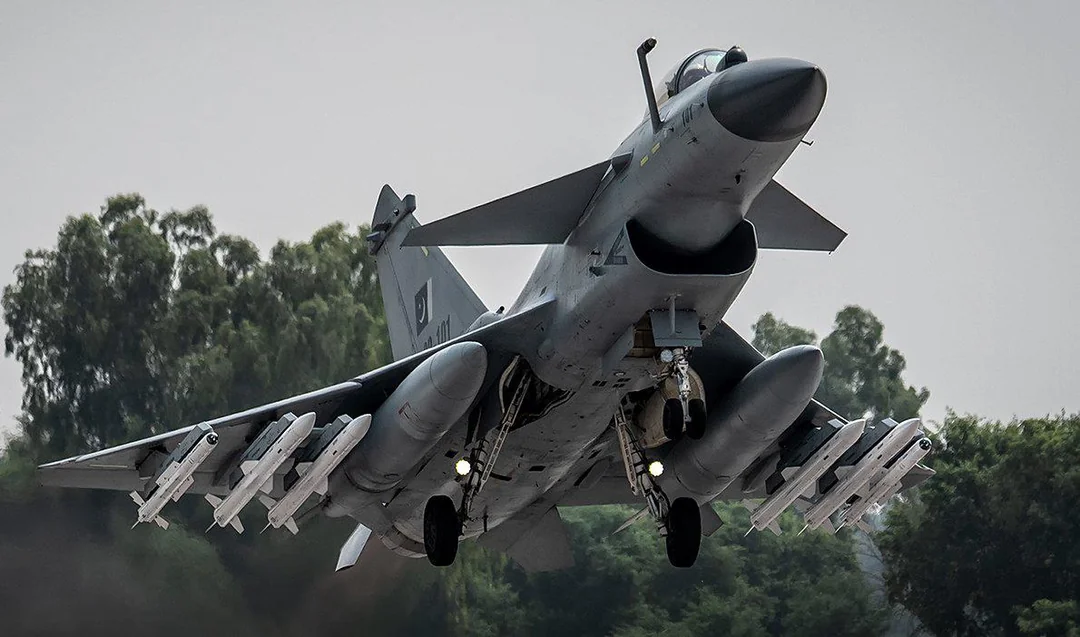In the world of military aviation, few stories are as dynamic as that of the Chengdu J-10, also known as the “Vigorous Dragon.” This single-engine multirole combat aircraft, developed by China’s Chengdu Aircraft Cooperation (CAC), has recently emerged as a symbol of Beijing’s growing technological prowess. What was once mocked as an unproven and reverse-engineered aircraft has now become epicenter of global aviation.
Back in the 1980s, China’s People’s Liberation Army Air Force (PLAAF) was largely equipped with outdated Soviet designs like the J-6 and J-7, which were essentially copies of the MiG-19 and MiG-21 aircrafts. These aircraft deigns were obsolete and were inadequate for modern combat. This realization deepened after Beijing witnessed impressive performance of United States’ F-15 Eagle and F-16 Falcon aircrafts in first Gulf War (1991) against veteran Iraqi air force predominately equipped with Soviet origin fighters including modern MiG-25 Foxbat and MiG-29 Fulcrum jets. Recognizing this major limitation, China began to focus on procurement and development of fourth generation aircrafts. As stop gap measure, China procured numerous examples of Russian Flankers including Su-27UBK and Su-30MKK/MK2.
For development and production of indigenous fighter aircraft, several design proposals were submitted. Eventually, the winning concept came from the Chengdu Aircraft Industry Group (CAIG). Their design was a delta wing with canards, bearing a strong structural resemblance to the Israel’s cancelled Lavi aircraft. But J-10 wasn’t exactly a copy of foreign design but rather a domestic product derived from the J-9, a double-delta canard configuration aircraft that had been canceled in the late 1970s.
Development of the aircraft dragged through the 1990s, hindered by budgetary constraints, and technical difficulties. The engine in particular proved to be a major obstacle. The first iteration of indigenous WS-10 was unreliable and underpowered, far from the standards required for a modern fighter. To overcome this problem, China turned to Russia and secured the AL-31FN engine, the same one used in the Su-27. Finally, in on March 23, 1998, the J-10 took to the skies for its maiden flight in Sichuan province, piloted by Li Gang. The aircraft’s sleek delta-wing profile and agile maneuverability marked a significant milestone for Chinese aviation. By 2005, the J-10A variant entered service, initiating a new era for the People’s Liberation Army Air Force (PLAAF). While the J-10A was a leap forward compared to earlier Chinese jets, it was not without shortcomings. It lacked cutting-edge avionics, modern precision weapons, and advanced electronic warfare systems. Yet, it represented a critical stepping stone in Chinese aviation industry.
As China’s economy boomed in the early 21st century, its military-industrial complex also flourished. With the foundation laid by the J-10A, the next iteration—J-10B—took the concept further, incorporating several major upgrades that signaled China’s rapid advance in aerospace engineering. Visually, the most notable change in the J-10B was the adoption of diverterless supersonic inlets (DSI), replacing the older rectangular inlets with a simpler, more efficient design. This upgrade reduced the aircraft’s radar cross-section and improved supersonic airflow characteristics. Moreover, the radar dome was modified to house a more sophisticated radar system, vastly improving target acquisition and tracking capabilities. Internally, the J-10B received a complete cockpit overhaul. Digital glass displays, improved hands-on-throttle-and-stick (HOTAS) controls, and more integrated avionics reduced pilot workload and enhanced situational awareness. The aircraft could now deploy advanced beyond-visual-range (BVR) missiles like the PL-12, as well as precision-guided munitions including satellite- and laser-guided bombs, finally making the J-10B a true multirole platform. But the engine was still Russian as fully operational WS-10 was still awaited. Therefore, China produced relatively few J-10Bs. Instead emphasis was given to develop and mass produce the next and currently the most advance version of Vigorous Dragon, the J10C. With the J-10C, China essentially closed the gap between its fighters and those of the West. This version features a fully operational AESA radar, upgraded avionics, a new electronic warfare suite, and, most importantly, an improved version of the long-elusive WS-10 engine, finally allowing China to move beyond dependency on Russian engine. Despite continuous improvements in its airframe, avionics, and weapons, J-10 was still awaiting export success.
This wait eventually ended when Pakistan Air Force (PAF) signed contract for delivery of 36 J-10CE fighter aircrafts. On March 2022, six J-10CEs in PAF cameo landed in Pakistan. The induction of J-10CE, armed with state of art sensors and air-to-air missiles – including dual-pulse PL-15 BVR missile, marked a major leap in PAF modernization efforts. Currently, date 20 J-10CE aircrafts have been delivered from a total order of 36 airframes.
A major limitation of modern Chinese origin aircrafts was lack of experience in actual combat. Although JF-17 Thunder, a light weight multirole fighter aircraft jointly produced by Pakistan and China, has participated in real combat against India as well as Iran. But the fighting prowess of a pure Chinese origin fighter remained untested in real conflict. This ambiguity eventually came to clarity on 07 May 2024, when PAF J-10CE engaged in historic air combat against Indian Air Force (IAF). For countering large IAF offensive package, comprising of high-end Rafale-F3R aircrafts, Su-30MKI, Mirage-2000H, MiG-29UPG, and Heron drones supported by AWACS, PAF employed its own defensive package led by freshly inducted J-10CE aircrafts. What followed was a watershed moment in modern combat aviation. Reportedly, J-10CE, in BVR engagement, successfully shot down three Indian Rafale F3R aircrafts and a Su-30MKI using PL-15 BVR missiles. In total, IAF allegedly lost six manned aircrafts and two MALE drones on 07 May 2025 against PAF. Despite possessing Meteor BVR missile of somewhat equivalent capability and Spectra EW suite, Indian Rafale aircrafts were neither able to shot down any PAF aircraft nor they were able to protect themselves against PL-15s.
It is worth noting that its first time French Rafale fighter aircraft has been shot down in air to air combat. And just like PAF outclassed IAF in 2019 crisis in aerial engagement using F-16 and AIM-120C5 missile combination, this time it was J-10CE and PL-15 missile combination which surmounted IAF. By inflicting so many losses in counter-air campaign, J-10CE essentially enabled PAF to achieve psychological dominance over numerically bigger IAF in a matter of hour! With this remarkable feat, J-10CE not only became the first modern Chinese origin aircraft to secure the air-kill but it also established efficiency of modern Chinese military equipment.
It is worth mentioning that J-10 is not the tip of sphere of Chinese combat aviation. Currently fifth generation J-20 stealth aircraft is already operational within PLAAF with J-35 is in production phase for People’s Liberation Army Navy (PLAN) aircraft carrier operations. In parallel, China is also testing prototypes of sixth generation J-36 and J-50 aircrafts. Imagine, if a 4.5th generation aircraft like J-10CE can outclass French Rafale F3R and Russian Su-30MKI, then imagine what capabilities fifth and sixth generation aircrafts will put on table!
In sum, the story of the J-10 is a reflection of China’s broader journey. What began as an uncertain project to avoid dependency on outdated Soviet designs has become living proof of China’s indigenous air prowess. Thanks to successful employment of J-10CE by PAF, world has acknowledged the potential of Chinese origin military systems. Now Western analysts perceive Chinese air power as more credible threat than that of Russia. J-10 saga has also highlighted that the technological inferiority is not permanent, and that with sustained effort, investment, and ambition, any nation can secure airpower excellence.
Table of Contents
ToggleAhmad Ibrahim
Author is Research Associate at Pakistan Navy War College, Lahore.












